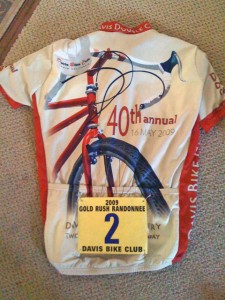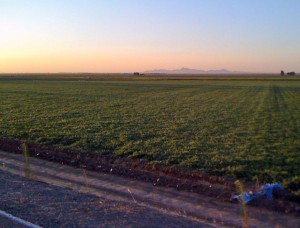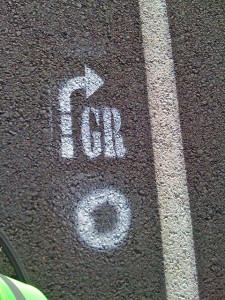Rolling for Time
Mile 0 to Mile 103.1

My plan for the Gold Rush Randonnée (GRR) was to break it into thirds of roughly 250 miles (or 400 kilometers) each: Davis to Susanville, Susanville to the turnaround at Davis Creek (near the Oregon border, by Goose Lake) and back again, then Susanville back to Davis. (If you look at the online map, you can select each third of the route by clicking on the œTracks in the upper-right corner. By default, all three sections of the route are shown. Clicking on a track will hide it.)
I counted on making each 250-mile leg in 20 hours (based on the 18 hours it took me to ride the 400k brevet earlier in the season). Doing so would allow ample time to rest in Susanville on the way out, sleep there overnight on the way back, and still allow for any mechanical breakdowns. If everything went perfectly, I hoped to finish by midnight Thursday.
The first hundred miles of the course, from Davis to Oroville, is essentially flat. It is all Central Valley agriculture with only three small towns in between. My plan was to make this stretch in six hours. That would give me a good time buffer so I could take a long break in Susanville.
My plan would have easily worked with a group. It was not so easy with my six-mile detour and no one in front to share pulling duties with. So, I rode along fairly quickly (19 “ 20 mph) and kept laughing at my mistake. I mean, I had planned everything so well. I had mapped the route out online months in advance; manually typed in the directions from the cue sheet to help me memorize the course; printed out the control closing times to calculate my windows of time to leave each one to make the next safely; packed each of my four drop bags with separate œOutbound and œInbound packages; labelled each and included instructions so I wouldn’t forget anything; carefully selected songs for the iPod to match different types of terrain, weather, and mood. I went so far as to coordinate sock colors with the jerseys I planned to change into.
But the one thing I left to the last minute “ really, the only decision I did not make beforehand “ was whether I would wear sunglasses or clear lenses for the start. It was sunny, and we had a five-mile leg right into the sun at the start, so sunglasses made sense. On the other hand, after we turned north I could ignore the sun. And if I had sunglass lenses in, I would have to stop at some point and change to clear lenses, which would mean possibly losing the group I hoped to be riding with.
In the end, I chose sunglasses, and in so doing, inadvertently left the clear lenses in a black fabric case on a black desk in a room with the shutters closed. Forty-five minutes into the ride, 25 minutes behind schedule, that seemed pretty funny to me.
Then a thought struck which panicked me. The first part of the route takes a roundabout way to Knight’s Landing, which meant someone could cut out five miles or so by taking a more direct route. On the 600k brevet in June, which traced this same route northwest of Davis, there was a secret control about 15 miles out to make sure no one cheated. It made sense there would be a secret control again. Controls are only open for specific periods of time based on a speed ranging roughly between 8 and 20mph. I realized that with my detour home, there was a chance I wouldn’t make that window. So I tried to calculate how long the secret control would be open, how fast I was going, where I was, and whether I would make it in time. I would have been humiliated to DNF in the first 15 miles of the ride.
And it’s one of the funny things about riding, at least for me, that I can fixate on a thought, and at the same time, never arrive at a satisfactory conclusion. It should have been easy to calculate 8mph x 15 miles and come up with a closing time, then compare that to my location and pace. I was riding roads that I ride virtually every Monday morning, so I know the landmarks, turns, small hills, stop signs, etc. It should have been easy to figure out my ETA at the15 mile mark. But I never did arrive at an answer. I would keep getting lost in the knowledge that it was possible to DNF 15 miles into the ride, only to start the calculations over again.
In the end, I made the control, and they confirmed what I already knew: I was last. Not that position is important: a randonnée is by definition not a race. But my mistake threatened my great plan for a long break in Susanville
After the secret control, the next landmark of note was Knights Landing. I knew this country from the Monday rides and the 600k I rode in early June, so I concentrated on my balance of speed and fatigue. While I wanted to make up time, it was more important not to let my heart rate run too high or to cross over my lactate threshold. That’s the surest way to run out of energy on a long ride.
At one turn to go north over Interstate 5, I came across Lee Mitchell who, as always, was driving the lead sag (support and gear) wagon. I stopped to top off my water. Just as I was pulling up, another rider took off. It turned out that he was riding with the lead group, took the turn fast and slipped out in some loose gravel. Lee had patched him back together, but the rider didn’t wear gloves so his hands got pretty scratched up. Lee was going to keep an eye on him because he didn’t think the rider would be able to go too much farther with that kind of hurt.
By the time I got to Knights Landing, I had passed two other riders. They were riding together and seemed perfectly comfortable at their slower pace. I wondered how they would ever make the entire course on time. I crossed the Sacramento River and turned onto a levee road. It is a very relaxed sort of road, winding along the river just high enough off the valley floor to give you a view of the farms and ranches extending to the north and east. I started to catch other riders on the road, and was feeling a little more relaxed. To my surprise, I came across four groups of people along here cheering riders on. The last spectators were a middle aged couple who had pulled out lawn chairs to the edge of their front lawn. They were drinking red wine and offered a toast as I went by. They asked if I was last. I said no, and asked them if I’d missed the turn. They said no and good luck and turned their attention back up the road looking for the next rider.

The sun was starting to get low now. I started a new calculation. There was a water stop at about mile 45. I wanted to make it that far before I had to change lenses or turn my lights on. So again, I started getting into time“speed“distance calculations to see if I would make it. At the same time I was trying to calculate, I had decided I would go to the 45-mile mark before I changed lenses even if it got dark. That made me try to ride a little faster.
Which is another strange thing about riding a bike. For some reason, not stopping can somehow become the most important consideration in making plans, either beforehand or on the fly. There is no practical reason I couldn’t reach down and turn on the light. And it wouldn’t take more time to change lenses out on the levee than it would at a water stop. But the psychological effect of making an unplanned stop is huge. It breaks momentum, breaks concentration, requires re-calculation. All of these minor, minor issues in reality, but huge in the reality of cycling. Your 19mph average speed over 20 miles might drop to 18.8mph because of a two minute stop. But it is still enough of a difference to make you ride in the dark with sunglasses to avoid that delay.
In the end, I made the stop with plenty of light even though the sun had set. I changed my lenses, refilled water bottles, turned on the light, chatted with the folks working there “ all while swatting swarms of mosquitoes “ and made it back out in about five minutes.
Some people had left not long before me, so now I had some rabbits to chase. This part of the ride was fun. The air was cooling. The orange light in the western sky was reflecting in channels between the rice fields. Frogs were starting to croak. The moon, one day short of full, was rising in the east. I was fully warmed up and the road was dead straight and flat.
This is my riding: Central Valley flat. There is a French term for people accustomed to this type of riding: Rouleur. And though it seems easy, people who don’t ride flats regularly get beaten down a little bit by this type of riding. It’s monotonous for one thing, and they don’t deal with wind as well, don’t feel the subtle rises or take advantage of the equally subtle drops. To me this is quick, easy riding that takes no mental effort, releasing me to focus on whatever goal I happen to have. In this case, my goal was to make up lost time.
I saw tail lights ahead, put my head down, and started to chase them. The pavement was fresh chip seal, a rough finish that is uncomfortable and slow. But the workers had left about a six inch-wide strip of the old smooth pavement untouched in the middle of the road. (For those of you who don’t ride, pavement quality becomes a huge concern to those of us who do. Ask any cyclist you know about pavement in your area, and they will be able to tell you about every rut, bump, and hole in incredible detail.) The road was empty of cars, so I rolled right up the middle, swerving every 10 to 20 feet to go around the yellow lane reflectors. It was a fun game. I could see riders I passed looking over at me, and I imagined they were trying to figure out what the hell I was doing in the middle of the road. Passing your ass on this smooth pavement while you ride on that bumpy crap is pretty much what I was thinking. My thought processes are not always as elevated as I would like.
I vaguely knew the route through this area, but not in detail. There was a group of riders ahead of me. I couldn’t tell how many, but enough to follow their tail lights from almost a mile back. Occasionally, the lights would disappear in front of me and reappear on some tangential course. It was cool watching the lights glide over the fields. When that happened, I would start watching for an intersection, then turn once I saw where the lights were headed.
I rolled into Sutterville. It was fully dark now, and other riders were there tending to their business. I switched empty water bottles from my frame for full ones from my seat post, mixed some electrolyte drink, and got going again. It’s kind of ironic, now that I think about it, but as important as it is not to stop in the middle of a leg, it is equally important to make sure you do stop at any major landmark, no matter how short the stop is. There is something pleasing about arriving, getting off the bike, and getting back on again. Conversely, there is also something enervating about looking forward to a landmark, planning to break, and not allowing yourself even that two-minutes of rest. A lot of cycling is played out in your head.
From Sutterville, the course continued north along the east side of the Sutter Buttes, past more ranches and fields, and on into the town of Gridley. I caught up to fellow club member Jonathan Gray who rides a recumbent. It was nice to have company for a while, even if he was too low to help pull me along. We rolled along chatting as if we were on one of the weekday rides together, picking up and dropping other riders along the way. That made the long straight stretches of road to Gridley a lot more pleasant.
There is not a whole lot to see in Gridley. It’s like so many other agricultural towns scattered up and down the Central Valley: gas stations, a few restaurants and businesses . . . nice enough, but nothing spectacular. But for some reason, I noticed it had a Taco Bell, and that triggered a craving for a 7- Layer Burrito. Taco Bell food is crap. I sometimes eat there because it is the only non-meat fast food I can find and, more often than not, regret it afterward. Why would I want to eat there now? I didn’t know, but I made a mental note to stop by there on the way back home as a way of putting aside the thought of an unanticipated stop now.
Not long after Gridley, the course started into the small rollers leading to the foothills of the Sierra Nevada. Jonathan started to cramp a little, so he told me to go ahead. I did, and soon enough, arrived at Oroville control. I got there at 12:28am, about half an hour later than I had hoped “ about the same time it took me to go home and get my clear lenses. I checked in, ate, and got the bike ready to go again. Then I visited for a while with Cary Thompson, one of my weekday ride friends working there. I also decided to nap. I wasn’t tired, but knew I would be. One of the things I learned for myself (and from other riders) on the 600k, is that your circadian rhythm will make you sleepy at unpredictable times. On the 600k, for instance, I got very sleepy around 7am, well after it was light outside. So I lay down in a large open room and pulled a blanket over me hoping to disrupt that pattern. I only closed my eyes for fifteen minutes, but thought that would be enough. I was rolling again at 1:30.
Next: Oroville to Taylorsville
